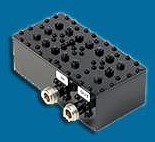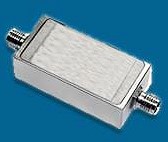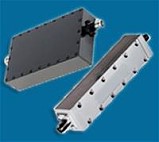|

Sam Benzacar of Anatech Electronics, an RF and microwave filter company, has published
his November 2023 newsletter that, along with timely news items, features his short
op-ed entitled "If Extraterrestrial Life is out There, We're Closer to Finding It."
In it, Sam discusses the current state of the worldwide search for alien intelligent
life. SETI (Search for Extraterrestrial Intelligence) has been around for as long
as I remember - established November 11, 1984. That means SETI and related efforts
have been at it for four decades, with no qualifying signals having ever been identified
(which is not to say might have been received but not recognized). That is just
a blip in time on a universal scale, so it is no reason to demur the effort. Astronomical
equipment in all wavelengths - radio, microwave, mm-wave, infrared, visible, ultraviolet,
x-ray - is advancing in sensitivity and speed at an extreme rate. Keep in mind that
prior to the Hubbell
Space Telescope, there was still a debate as to whether the entire sky, if examined
closely enough, would be filled with celestial objects. Now, telescopes operating
outside the optical range with fine resolution are detecting stars and galaxies
hiding behind regions of interstellar gas that blocks light in the red-to-blue visual
spectrum. A civilization would need to have been emitting electromagnetic signals
for much longer a time than the 150 years or so of those originating from the Earth
in order for the probability of something intercepting our position in the universe
with enough power to detect. If any ET was intentionally attempting to another civilization,
it would certainly devise a message easy enough for any other being to recognize
as intelligent data. In 1984,
Carl Sagan's team blasted
an encoded message toward globular cluster M13 in the constellation of Hercules
using the 1000 meter Arecibo radiotelescope in Puerto Rico. It was designed to be
easy to understand. There has been no response as of this writing. Of course some
people think our efforts to contact alien sentient beings could result in informing
a hostile force where we are located, ultimately marking Earth for destruction.
A Word from Sam Benzacar - If Extraterrestrial Life is out There,
We're Closer to Finding It
 By Sam Benzacar By Sam Benzacar
Most people would agree that we are not alone in the universe if anyone cared
to ask. So, it stands to reason that extraterrestrial beings, whatever and wherever
they may be, must have some way to communicate over long distances. The search for
extraterrestrial intelligence has captivated us for centuries. Although the search
has yet to yield definitive proof of life beyond Earth, significant advancements
in technology and research methods have propelled SETI forward in recent years.
A recent initiative called Breakthrough Listen is expanding our reach.
Launched in 2015, Breakthrough Listen, a 10-year, $100 million project funded
by Russian-Israeli billionaire and physicist Yuri Milner, is the most comprehensive
and ambitious SETI project ever attempted, utilizing a powerful network of telescopes
and advanced data analysis techniques.
Breakthrough Listen has expanded the scope of SETI by searching for both radio
and optical signals from exoplanets, galaxies, and beyond. It focuses on various
targets, from nearby stars and galaxies to the entire galactic plane. It listens
for radio signals not produced by natural cosmic processes while also searching
for optical laser emissions, which could be another form of extraterrestrial communication.
The project uses some of the most impressive radio telescopes in the world, including
the world's largest steerable radio telescope, the Green Bank Telescope in West
Virginia, as well as the Parkes Telescope in Australia, and the Automated Planet
Finder, a telescope at Lick Observatory on the summit of Mount Hamilton in the Diablo
Range just east of San Jose, California.
The radio telescopes are sensitive enough to detect "Earth-leakage" levels of
radio transmission from stars within 5 parsecs (5x3.26 light-years). They can detect
a transmitter of the same power level as an aircraft radar from the 1,000 nearest
stars. Together, the radio telescopes will cover ten times more sky than previous
searches and scan the entire spectral region from 1 to 10 GHz range, the so-called
"quiet zone" in the spectrum where electromagnetic radiation is unobscured by cosmic
sources or Earth's atmosphere. The project is projected to generate as much data
in one day as previous SETI projects generated in one year.
Despite the lack of immediate results, SETI has continued to evolve and expand.
In recent years, SETI has witnessed several notable advancements, including the
development of more sensitive and powerful telescopes. New telescopes like the MeerKAT
and the Square Kilometer Array (SKA) can detect fainter signals from greater distances,
dramatically expanding the search volume.
 More Available Spectrum
on the Way More Available Spectrum
on the Way
The government has devised a plan to improve wireless spectrum management to
maximize its use. This includes identifying frequencies that can be repurposed for
new purposes and improving the management of frequency bands to ensure that both
the public and private sectors have access to the spectrum they need to deliver
services. The strategy was created by the National Telecommunications Information
Administration (NTIA), an agency in the Department of Commerce, in conjunction with
the Federal Communications Commission (FCC). It's based on four pillars of “essential
actions.”
The first is a study of 2.78 GHz of spectrum for possible repurposing within
five bands: 3.1 to 3.45 GHz, 5 to 5.09 GHz, 7.125 to 8.4 GHz, 18.1 to 18.6 GHz,
and 37to 37.6 GHz to support applications such as wireless broadband, drones, and
satellite operations. The second pillar requires long-term planning for spectrum
allocation with feedback from industry, federal agencies, and advisory groups, and
the third is designed to encourage the use of new techniques such as spectrum sharing
to increase efficiency and the last pillar is the development of workforce skills
to meet future operational, technical and policy roles in the spectrum ecosystem.
 Using RF Energy to Secure
Nuclear Weapons Using RF Energy to Secure
Nuclear Weapons
A new technique devised by researchers led by the Max Planck Institute for Security
and Privacy aims to remotely monitor the removal of warheads stored in military
bunkers by tracking objects' movement in a room using mirrors and RF energy. The
presence and number of weapons at a site cannot be verified via satellite imagery
or other means because they cannot penetrate the storage vaults. As a result, the
9,000 nuclear weapons are not accounted for under existing nuclear arms control
agreements.
The scientists installed 20 adjustable mirrors and two antennas to monitor the
movement of a barrel stored in a shipping container. One antenna emits signals that
bounce off each mirror to create a unique reflection pattern detected by the other
antenna and provide information on the location of objects in the room. If an object
is moved, a different reflection pattern will be created. The researchers say the
system has proven sensitive enough to detect whether a barrel had shifted by just
a few millimeters. The antenna-and-mirror technique doesn't require secure communication
channels or tamper-resistant sensor hardware.
 More Room for Very-Low-Power
Devices More Room for Very-Low-Power
Devices
FCC commissioners have approved using very-low-power (VLP) unlicensed devices
to operate in the 6 GHz band that many critical-communications officials consider
to be the foundation of mission-critical and business-critical networks' backhaul
solutions. Chairwoman Jessica Rosenworcel highlighted the significance of unlicensed
devices to the economy, with Wi-Fi as the final wireless connection for many end-user
devices. Expanding unlicensed use in the 6 GHz band is a critical component in maintaining
this connectivity momentum, according to Rosenworcel.
“We are opening up 850 MHz of the 6 GHz band to small mobile devices operating
at very low power while putting in place common-sense safeguards to protect incumbent
uses”, she continued. “We are also proposing to open up an additional 350 megahertz
of the 6 GHz band for very-low-power devices. New immersive, real-time applications
can be enabled because we now have the unlicensed bandwidth, with high capacity
and low latency.”
 New "Atomic" RF Sensor Revealed New "Atomic" RF Sensor Revealed
An atomic RF sensor has been developed that offers enhanced sensitivity and versatility
and is suited for defense and satellite technology, according to a paper published
in Applied Physics Letters by researchers at the University of Otago in New Zealand.
They used a small glass bulb containing an atomic vapor to demonstrate a new form
of antenna. The bulb uses laser beams, can be placed far from any receiver electronics,
and can outperform current antenna technologies in sensitivity, tunability, and
size. A key benefit is that they cover vast frequencies so soldiers can use just
one instead of multiple antennas. The new design is portable and can be taken outside
the laboratory. In a demonstration, the sensor could efficiently measure fields
at a distance of 100 ft. using a free-space laser link.
Anatech Electronics Introduces a New Line of Suspended
Stripline and Waveguide Type RF Filters
Check out Our Filter Products



Cavity Band Pass Filters
LC Band Pass Filters Cavity Bandstop/Notch Filter
About Anatech Electronics
Anatech Electronics, Inc. (AEI) specializes in the design and manufacture of
standard and custom RF and microwave filters and other passive components and subsystems
employed in commercial, industrial, and aerospace and applications. Products are
available from an operating frequency range of 10 kHz to 30 GHz and include cavity,
ceramic, crystal, LC, and surface acoustic wave (SAW), as well as power combiners/dividers,
duplexers and diplexers, directional couplers, terminations, attenuators, circulators,
EMI filters, and lightning arrestors. The company's custom products and capabilities
are available at www.anatechelectronics.com.
Contact:
Anatech Electronics, Inc.
70 Outwater Lane
Garfield, NJ 07026
(973)
772-4242
sales@anatechelectronics.com
Posted December 1, 2023
|



























 By Sam Benzacar
By Sam Benzacar More Available Spectrum
on the Way
More Available Spectrum
on the Way  Using RF Energy to Secure
Nuclear Weapons
Using RF Energy to Secure
Nuclear Weapons  More Room for Very-Low-Power
Devices
More Room for Very-Low-Power
Devices  New "Atomic" RF Sensor Revealed
New "Atomic" RF Sensor Revealed 




